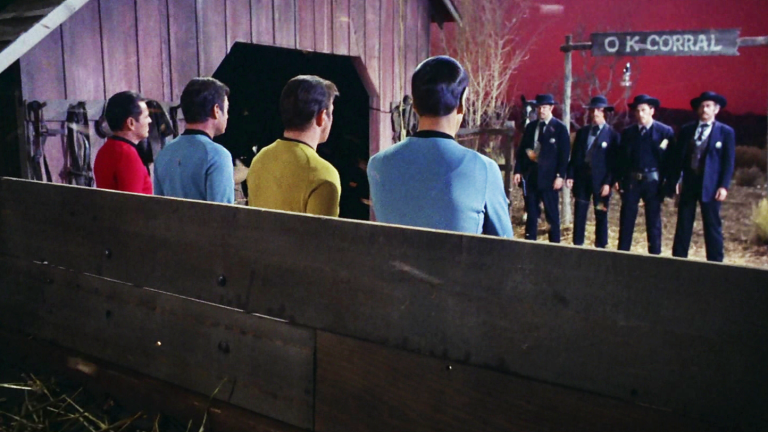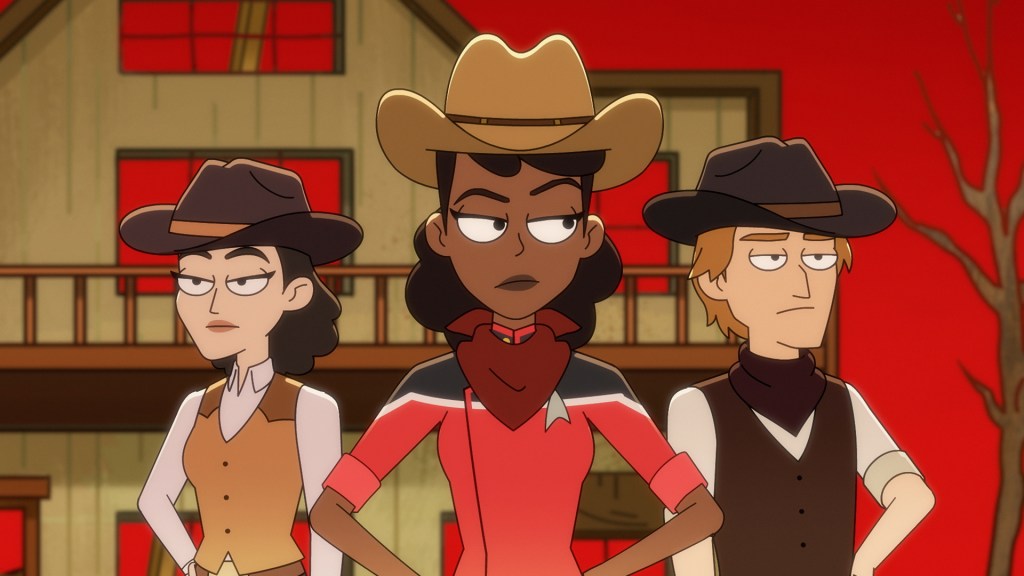Do Star Trek Characters Watch Star Trek?
In Lower Decks, we’ve learned that Starfleet calls famous missions by the same name as the episode titles in our Star Trek universe.

This Star Trek: Lower Decks article contains spoilers for Season 2, Episode 8 “I, Excretus.”
For Star Trek fans who worry that Lower Decks somehow doesn’t “count” because it’s a comedy, nothing could be further from the truth. Not only does Lower Decks count as real Star Trek canon it also actively explores Trek canon, constantly illuminating that what we think we know about the world of the Federation, Starfleet, the Klingon Empire, etc. The result? What we know is actually very limited by our perspective of what we’ve seen on the various live-action Trek shows. Lower Decks creator Mike McMahan has called Lower Decks a “rosetta stone” of Star Trek canon more than once. And, perhaps there’s no better example of this than episode 8 of season 2, the episode, “I, Excretus.”
Here’s how this episode lays out an entirely new way of thinking about how Starfleet thinks about itself. Does it feel like Starfleet is obsessed with the adventures of the various Enterprises? Well, what Lower Decks asserts is, maybe there’s a good reason for that.
The basic premise of this episode focuses on the crew of the USS Cerritos getting run through a series of holographic drills to determine how good the crew is at their various jobs. The bigger story is, at first, one about social class. The drill instructor — Shari Yn Yem — flips the ranks between the bridge crew and the “lower decks,” which means that each side gets to experience how the other half lives. To that end, the holographic drills that Mariner, Tendi, Boimler, and Rutherford endure are all huge ethical dilemmas, life or death struggles, or, stuff with horses and emotional plagues. In other words, the Lower Deckers do a kind of greatest hits of stories from The Original Series and The Next Generation. At one point, Mariner enters a simulation called “Mirror Universe Encounter,” in which she has to try to infiltrate the Terran Empire. This simulation is basically a remix of the TOS episode “Mirror, Mirror,” and everything Mirror Universe related on Discovery. Later, Mariner enters an “Old West Planet” simulation, which she calls “a Starfleet classic…yeehaw!” This references the TOS episode “Spectre of the Gun,” the TNG episode “A Fistful of Datas” and the Enterprise episode “North Star.” Later, Mariner enters a simulation called “Naked Time,” in which the crew succumbs to a virus that makes them, well, drunk and horny.

While it’s tempting to say that “Naked Time” is a long-hanging fruit joke that comes from 2021, the truth is, the title “The Naked Time,” refers to an episode of TOS in which the crew does succumb to a virus that makes them act drunk and horny. This episode was written by John D. F. Black and was later quasi-remade as the episode “The Naked Now” on TNG in which the crew encounters pretty much the same virus, only slightly different. (For reference, “The Naked Now” is the episode where Data mentions that he is “fully functional” for the first time. In the same episode, Data also corrects Riker about the proper uses of the words “suck” versus “blow,” relative to space problems. You can’t make this stuff up. It’s hard to believe Star Trek is real sometimes, you know?)
Anyway! The point is the simulation is called “Naked Time,” which is very close to the episode title in “our” reality. And, when we see a larger readout of all the simulations running, several, several of them have names almost identical to actual episodes of Star Trek.
Here’s an example of one prominent moment, in which we see a bunch of the simulation names…
- Time Trap (“The Time Trap,” TAS)
- Tribble Troubles (“The Trouble Will Tribbles,” OST)
- From Q to Q (Any Q episode?)
- Borg Encounter (Obvious)
- Cause & Effect (“Cause and Effect,” TNG)
- Natural Selection (“Unnatural Selection, TNG)
- Evolution (“Evolution,” TNG)
- Chain of Command (“Chain of Command,” TNG…an episode Lower Decks can’t stop referencing.)
- Hero Worship (“Hero Worship,” TNG)
- Carbon Based Units (Star Trek: The Motion Picture)
- Naked Time (“The Naked Time,” TOS, et al.)
Now on several occasions, Lower Decks showrunner Mike McMahan has said “people on Star Trek watch Star Trek.” The best example of this is when Riker runs a simulation of the NX-01 Enterprise in the episode “These Are the Voyages…” What Lower Decks has done, since Season 1, is take that notion, and apply it more broadly. In the Season 1 episode “Much Ado About Boimler,” a Starfleet officer who has been de-aged, mentions that he is “half a Rascal” which references the TNG episode “Rascals.” The idea here, solidified by the latest Lower Decks, is that various simulations, or logs from big Starfleet missions, become public knowledge to the rest of the Federation. And, most relevantly, all of these famous adventures have names that are very similar to the ones we are familiar with. (Though, in fairness, Barnes doing a simulation called “Whale Rescue,” probably should have been called “The One With the Whales,” right?)
Later in the episode, when Mariner and Captain Freeman figure out that Shari Yn Yem is trying to screw them over, she taunts, “You’re on a California class ship, most of the Federation doesn’t even know you exist.” Now, this statement hammers home the entire point of Lower Decks, insofar as the show is about starships doing less than glamorous work. But, what gets subtly, and smartly established in this episode is that the ships that may go unnoticed, all totally model themselves after the Enterprises, Voyagers, and Defiants of the fleet.
Why? Well, Shari Yn Yem did not invent these simulations. As she reveals, she simply “goosed” the difficulty levels to try and make the crew of the Cerritos look bad. When the crew is supposed to “steal the Cerritos and rescue Spock from the Genesis planet,” the audience (probably) knows that’s a reference to Star Trek III: The Search for Spock. Shari Yn Yem calls it a “classic,” just like Mariner called the “Old West Planet” a “classic.” The implication here is clear. The adventures of the various Enterprises (or Voyagers or Defiants) aren’t just canonical to Star Trek fans, these adventures have been translated to other (future) media for a very long time within the Federation itself. People do know about the Enterprise in the big world of the 24th century. Even Season 1 of Picard proved that — in the very first episode, reporters were in Jean-Luc’s house!
Appropriately enough, this outcome might be what Gene Roddenberry intended. In the forward to Roddenberry’s wild novelization of Star Trek: The Motion Picture, Kirk reveals that he is aware of various forms in which the adventures of the Enterprise have been made available for mass consumption in 23rd century media. In the only Star Trek book penned by the creator of Star Trek, people in Star Trek apparently read or watch Star Trek. Before Lower Decks, the only examples of this meta-fiction were the Enterprise finale “These Are the Voyages” and this vague assertion from Roddenberry in the TMP novelization.
But now, Lower Decks has made all of it very clear. The canon of Star Trek is comprised of stories from starships that have become famous over time. Even in the egalitarian world of Trek, in the far future, there’s still pop culture, which means some space stories are more popular than others. And it turns out, the true-life stories of people on ships called Enterprise are hits with the general public. Every. Single. Time.
Lower Decks airs on Paramount+.
